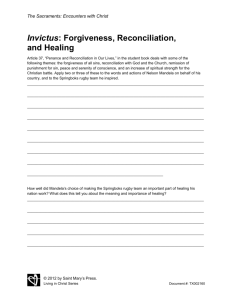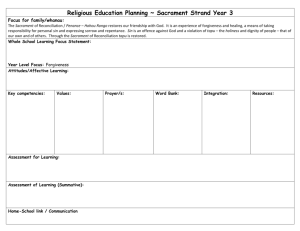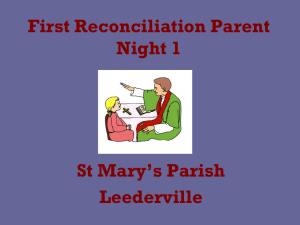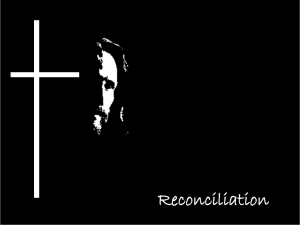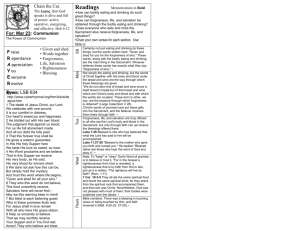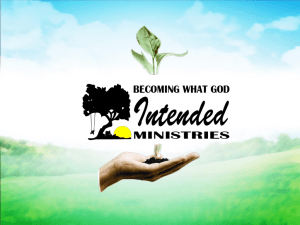Unit 2.6 Reconciliation - Catholic Education Office Sydney
advertisement
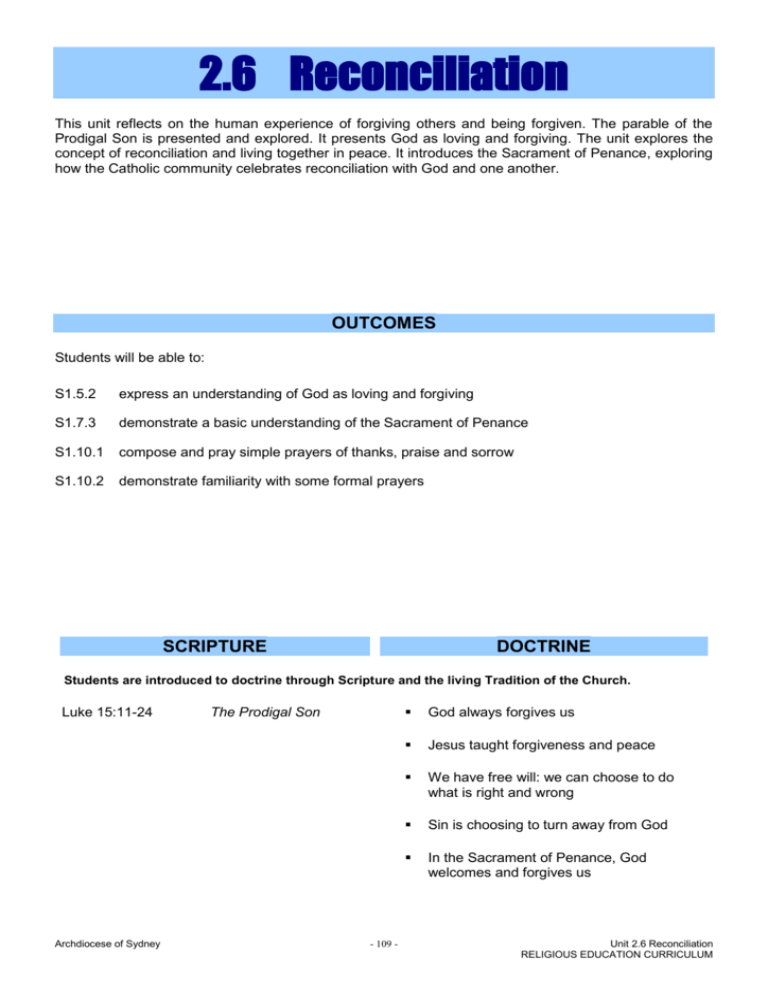
2.6 Reconciliation This unit reflects on the human experience of forgiving others and being forgiven. The parable of the Prodigal Son is presented and explored. It presents God as loving and forgiving. The unit explores the concept of reconciliation and living together in peace. It introduces the Sacrament of Penance, exploring how the Catholic community celebrates reconciliation with God and one another. OUTCOMES Students will be able to: S1.5.2 express an understanding of God as loving and forgiving S1.7.3 demonstrate a basic understanding of the Sacrament of Penance S1.10.1 compose and pray simple prayers of thanks, praise and sorrow S1.10.2 demonstrate familiarity with some formal prayers SCRIPTURE DOCTRINE Students are introduced to doctrine through Scripture and the living Tradition of the Church. Luke 15:11-24 Archdiocese of Sydney The Prodigal Son - 109 - God always forgives us Jesus taught forgiveness and peace We have free will: we can choose to do what is right and wrong Sin is choosing to turn away from God In the Sacrament of Penance, God welcomes and forgives us Unit 2.6 Reconciliation RELIGIOUS EDUCATION CURRICULUM SPIRITUAL REFLECTION FOR TEACHERS “I have often said, ‘I forgive you’, but even as I said these words my heart remained angry or resentful. I still wanted to hear the story that tells me that I was right after all; I still wanted to hear apologies and excuses; I still wanted the satisfaction of receiving some praise in return – if only the praise for being so forgiving! But God’s forgiveness is unconditional; it comes from a heart that does not demand anything for itself, a heart that is completely empty of self-seeking. It is this divine forgiveness that I have to practise in my daily life. It calls me to keep stepping over all my arguments that say forgiveness is unwise, unhealthy, and impractical. It challenges me to step over all my needs for gratitude and compliments. Finally, it demands of me that I step over that wounded part of my heart that feels hurt and wronged and that wants to stay in control and put a few conditions between me and the one whom I am asked to forgive. This ‘stepping over’ is the authentic discipline of forgiveness. But every time that I can step or climb over that wall, I enter into the house where the Father dwells, and there touch my neighbour with genuine compassionate love.” (Henri J M Nouwen)1 1 When have I found it difficult to forgive someone? What sometimes holds me back from forgiving others? Recall a time when you have offered forgiveness to someone. What was the experience like for you and the person involved? H J Nouwen, The Return of the Prodigal Son, (1994), Darton, Longman and Todd Ltd, London, pp129,130 Archdiocese of Sydney - 110 - Unit 2.6 Reconciliation RELIGIOUS EDUCATION CURRICULUM CATECHISM OF THE CATHOLIC CHURCH Excerpts from the Catechism of the Catholic Church are included below as information for teachers. They present the Church’s teachings contained in the unit. 1435 Conversion is accomplished in daily life by gestures of reconciliation, concern for the poor, the exercise and defense of justice and right, by the admission of faults to one's brethren, fraternal correction, revision of life, examination of conscience, spiritual direction, acceptance of suffering, endurance of persecution for the sake of righteousness. Taking up one's cross each day and following Jesus is the surest way of penance. 1449 The formula of absolution used in the Latin Church expresses the essential elements of this sacrament: the Father of mercies is the source of all forgiveness. He effects the reconciliation of sinners through the Passover of his Son and the gift of his Spirit, through the prayer and ministry of the Church: God, the Father of mercies, through the death and the Resurrection of his Son has reconciled the world to himself and sent the Holy Spirit among us for the forgiveness of sins; through the ministry of the Church may God give you pardon and peace, and I absolve you from your sins in the name of the Father, and of the Son and of the Holy Spirit. 1443 During his public life Jesus not only forgave sins, but also made plain the effect of this forgiveness: he reintegrated forgiven sinners into the community of the People of God from which sin had alienated or even excluded them. A remarkable sign of this is the fact that Jesus receives sinners at his table, a gesture that expresses in an astonishing way both God's forgiveness and the return to the bosom of the People of God. 1480 Like all the sacraments, Penance is a liturgical action. The elements of the celebration are ordinarily these: a greeting and blessing from the priest, reading the word of God to illuminate the conscience and elicit contrition, and an exhortation to repentance; the confession, which acknowledges sins and makes them known to the priest; the imposition and acceptance of a penance; the priest’s absolution; a prayer of thanksgiving and praise and dismissal with the blessing of the priest. SCRIPTURE: BACKGROUND INFORMATION Luke 15:11-24 The Prodigal Son This is a beautiful and familiar parable of forgiveness. The younger son squanders his family inheritance and yet the father welcomes him back into the family as if nothing has happened. This is what God is like. The words “lost and found” are repeated several times in the text. The young son is “lost and found”. But no doubt the father felt “lost and found” again when his son returned home. The older brother seems to remain lost because he cannot yet understand and accept such abundant forgiveness. In fact the Greek text hints at this. It uses two different words for son. When it refers to the younger brother after he has returned he is (uios) the adult son. But the elder brother is always referred to as (teknon) child son. The younger brother “came to his senses” (verse 17) and realized who he was and what he had done and forgave himself enough to return home. He matured and grew up. Archdiocese of Sydney - 111 - Unit 2.6 Reconciliation RELIGIOUS EDUCATION CURRICULUM SUGGESTED ASSESSMENT Suggestions for determining students’ development towards the achievement of the outcomes are included below: S1.5.2 express an understanding of God as loving and forgiving The students typically might: recount/retell the story of the Prodigal Son respond to the story: oral or written, art, movement, wondering…etc S1.7.3 demonstrate a basic understanding of the Sacrament of Penance The students typically might: identify and sequence the main parts of the Sacrament of Penance S1.10.1 compose and pray simple prayers of thanks, praise and penitence The students typically might: write a simple ‘sorry’ prayer S1.10.2 demonstrate familiarity with some formal prayers The students typically might: know the Act of Contrition RESOURCES To Know Worship and Love – Book 2, Chapters 10, Part 1 and 2, (2005), James Goold House Publications, Melbourne, Victoria To Know Worship and Love – Big Book, Parables Jesus Told, ‘The Prodigal Son’ Teacher Resources Wintour R, (2004), Just Imagine 3, Mountjoy Enterprises, Brisbane, Qld Audio Visual Costello G, Ricky’s First Reconciliation: the Rite of Reconciliation, Veritas, Australia Powell, J, And Jesus said….”You are forgiven”, ‘And Jesus Said’ series, PO Box 8622, Gold Coast MC, Qld, 9726 Skateboard: A First Reconciliation Film, Christian Home Videos Music Miffleton J, (1984), Wake Up the Earth, North American Liturgy Resources, Arizona NOTE: See RE Online for additional resources for this unit. Archdiocese of Sydney - 112 - Unit 2.6 Reconciliation RELIGIOUS EDUCATION CURRICULUM UNIT CONTENT A: THE PRODIGAL SON The parable of the Prodigal Son tells us about God’s love and forgiveness. Students will: explore the story of The Prodigal Son and what it tells us about God’s love and forgiveness reflect on the choices they make and the consequences of these choices explore experiences of being forgiven and forgiving others BACKGROUND INFORMATION The parable of The Prodigal Son, also called the parable of the Forgiving Father or the Loving Father, is often used in association with reconciliation and forgiveness. The story has the power to teach and challenge. Jesus used parables to teach. Often the parable contained a paradox that challenged the accepted ways. Parables have many layers of meaning and the parable will speak to each person in different ways at different times. In this parable we encounter the unexpected. The return of the undeserving son is celebrated when we might have expected him to be chastised. Why? Engaging with your students in wondering what this parable is about will help each student to ‘find their meaning’, to engage creatively and to discover something about the lavish nature of God’s love. In this presentation of the parable, the focus is on the first section, the story of the younger son. The verses dealing with the elder brother are not told. The story ends as the father begins the celebration of his son’s return home. The father in this story loved his son so much that he gave him the freedom to make his own choices. The father waited with open arms and ready forgiveness to welcome his son back regardless of what he had done. The story reveals to us the lavish love and forgiveness of God. God’s love is beyond the limitations of our understanding. Through the power of the parable story, foundations can be laid for the students to develop an understanding of people loving and forgiving. It is important to recognise that students will focus on different aspects of the story. Some parts may relate more to their experience or understanding than others. Try to really ‘hear’ and ‘receive’ what they are saying. In so doing we model for the students the importance of listening to and learning from others. Human beings are born with the grace of free will and therefore have the capacity to sin. Sin is the breaking of relationship, the turning away from God. We are also graced with the capacity to love and the capacity to reconcile. One of the most powerful demonstrations of love is forgiveness, since Jesus said that the greatest expression of love is laying down one’s life for another. We all need forgiveness, for sin alienates us from God and others. Students could be guided to see the choices that build relationships and choices that break or erode relationships. They could begin to start seeing that asking for forgiveness and forgiving others is very much part of everyday life. We all need to do it. Human beings need forgiveness. People do not like feeling badly about what they have done. They want to feel friendly and loving towards others. When this happens it is a time of celebration. Archdiocese of Sydney - 113 - Unit 2.6 Reconciliation RELIGIOUS EDUCATION CURRICULUM SUGGESTED TEACHING/LEARNING STRATEGIES The following suggested activities are organised around the key elements of Telling the Story, Wondering, Exploring and Prayer. Teachers select, adapt or substitute activities, ensuring that each of the abovementioned elements is evident in the cycle of learning. Invite the students to identify ways that they know they are loved within their family situation. Think of a person who loves you and describe how they show their love. Think of someone you love and describe how you show them you love them. Tell the story of the Prodigal Son, KWL ch 10, Part 1, pp106-111 (Luke 15:11-24) using 2D masters on RE Online. Refer to ‘Resource Sheet 1’ for script from KWL. Present four or five ‘I wonder’ statements from KWL p112 to engage students in wondering together about the story. Finish with the question: I wonder which person in the story is most like God? Use KWL ch 10, Part 1 or Big Book, Parables Jesus Told, to revisit the story of the Prodigal Son. Engage with some more of the ‘I wonder’ statements on p112. Finish with: ‘I wonder why Jesus told this story.’ Remember there are no ‘right’ responses to these statements. Listen to and engage with all contributions. Invite students to choose a part of the story they would like to illustrate. They could journal an experience of theirs or of a family member being welcomed home. Divide class into seven groups to present a liquid picture of the story. Each group is given a phrase or two representing a key part of the story. Refer to ‘Resource Sheet 2’ or use similar text in R Wintour, Just Imagine 3, p51. As a group, the students are given time to make up a simple action to go with their part of the story. As a group, they learn the words and action to present together. Choose one person from each group to be a leader. This student will step forward, and say the phrase with action and the rest of their group will repeat the words and action twice. When all groups are ready arrange groups in the correct sequence for telling the story. Tell students we will be retelling the story of the Prodigal Son. Present the story in the following way: (You may need a couple of practice runs.) Teacher introduces the story with opening statement. First group will begin with student leader, stepping forward and saying the phrase with action which the group then repeats twice. The group then freezes. This process is repeated for each group until the last group finishes. The teacher concludes with a suitable ending. Find other ways to explore and engage with the story. Use tableau vivant to explore each character’s feelings and reactions. Tableau vivant – set the scene and then freeze. Each character steps out of the scene and expresses their thoughts and feelings. or Create a grab bag, which contains symbols and objects related to the story, eg characters, money, pig, party hat…. Retell the story together or in small groups. or Archdiocese of Sydney - 114 - Unit 2.6 Reconciliation RELIGIOUS EDUCATION CURRICULUM Use the phrases used for liquid picture, ‘Resource Sheet 2’, to create a wall story which students illustrate. This could be used for a sequencing/retelling activity. Give students the opportunity to use the materials used by the teacher to retell the story in their own words. This helps them to ‘stay with the story’ and ponder it. Identify the choices of the characters in the Prodigal Son. How did these choices make or break relationships? Identify choices they make. Classify these into choices that make or break relationships. Design a ‘Welcome Home’ heart. On one side of the heart children write about how it feels to know God always loves and forgives them. On the other side decorate with sequins, glitter and stickers etc. These hearts can be used in prayer celebration. Learn a song like the ‘Prodigal Round’ with actions by Jack Miffleton, Wake Up the Earth. Prayer celebration: Create a sacred space using coloured cloth, candle, Bible. Gather in a circle (sitting) with each student holding their ‘Welcome Home’ heart. Light candle and make Sign of the Cross. Proclaim the word (Lk 15:11-24). Invite each student to place their heart in the sacred space saying ‘God loves me’ as they place their heart. Shared prayer of thanksgiving for people who love us and help us make choices that build relationships. Prayer from KWL p113. Sing suitable song. Archdiocese of Sydney - 115 - Unit 2.6 Reconciliation RELIGIOUS EDUCATION CURRICULUM UNIT CONTENT B: THE SACRAMENT OF PENANCE The Sacrament of Penance is the Church’s celebration of God’s love and forgiveness. Students will: explore experiences of being forgiven and forgiving others learn prayers of forgiveness learn about God’s forgiveness through the symbols and rituals of the Sacrament of Penance BACKGROUND INFORMATION The Church celebrates the forgiving presence of God through the Sacrament of Penance. This sacrament ritualises, through word, gesture and symbols the restoration of relationship with God and others. Through this sacrament, the Church community continues Jesus’ ministry of forgiveness. Human beings, created in the image and likeness of God, are called into relationship with God. As such we are called to live in right relationship with ourselves, others, God and all creation. God has given us the freedom to make choices. Sometimes we make choices that enhance life and build relationship. Other times we make choices that diminish life and break relationships. ‘Sin’ is the term used to describe actions that erode or destroy our relationship with God and others. It is important that students come to see that they are capable of making both ‘good’ choices and ‘not so good’ choices and that these choices can affect others. The unit is laying the foundations for future understanding of sacraments and issues of ethics and morality in the Christian life. Human beings need to be forgiven. We often find we have damaged relationships by the way we behave – we sin by failing to love. For a relationship to be restored there needs to be reconciliation – an apology, willingness to forgive and healing. Hence, reconciliation is a deeply human experience. It is also a deeply religious experience. God forgives us continuously. God, who is forgiving, invites us to forgive others and to ask for forgiveness. Engaging with the students in wondering about reconciliation will help them to begin to reflect on the choices they make in relation to others. It is important students are given opportunity to wonder about and reflect on their own experiences of forgiveness – both being forgiven and forgiving another. The Sacrament of Penance or Reconciliation is the sacramental way that people seek and experience forgiveness within the Catholic community. In the sacrament, Jesus, through the Church, in the words and actions of the priest brings God’s forgiveness. The sacrament helps people take responsibility for their sins. They need to acknowledge them and confess them to God. As part of the sacrament people say sorry and receive God’s forgiveness. Their relationship with others and, most importantly, with God is renewed. God’s life of grace is restored in them and they are free to make other choices and grow in love and better ways of living. It is important as we explore this liturgical story with students that they see the celebration of forgiveness and reconciliation as an action of God through the Church community. Focusing on the idea of coming together in peace – an act that should be celebrated - will allow students opportunity to wonder about and bring to the liturgical story their own experiences. Archdiocese of Sydney - 116 - Unit 2.6 Reconciliation RELIGIOUS EDUCATION CURRICULUM There are three Rites of Reconciliation, that is, three ways to celebrate the Sacrament of Penance. First Rite of Reconciliation. The individual asks for God’s forgiveness. The individual penitent receives the sacrament with the priest. There is individual confession and absolution. Second Rite of Reconciliation. This is experienced as a community. We gather as a community and celebrate the liturgy. We seek individual confession and absolution. This is the rite most commonly celebrated in schools. Third Rite of Reconciliation. This is a community experience with communal absolution. It is used in emergency situations. Other penitential celebrations, as set out in Rites of Penance (Appendix II), identify the need for forgiveness, conversion and belief in a forgiving God. SUGGESTED TEACHING/LEARNING STRATEGIES The following suggested activities are organised around the key elements of Telling the Story, Wondering, Exploring and Prayer. Teachers select, adapt or substitute activities, ensuring that each of the abovementioned elements is evident in the cycle of learning. Create activities exploring the mending of something broken, eg plate, pot, torn page… Discuss the process of bringing parts together and mending them. Read KWL ch 10, Part 2, pp114-117. Engage with the first two or three ‘I wonder’ statements in KWL p118. Use children’s literature to explore elements of forgiveness. Role play situations of making up and breaking up. Have students share stories of their own experiences of making and breaking relationships. Think of your own story about being hurt by something that someone said or did. What happened? Did the person say sorry and were you able to accept the apology? How did you feel? How did they feel? What words were used? What gestures were used? Invite students to Pair and Share. How does it feel to say sorry and what words and gestures can be used? Lead children through a reflection on: What does forgiveness feel like? smell like? taste like? look like? sound like? eg: Forgiveness feels like a warm bubble bath / Forgiveness smells special like my mum’s favourite perfume / Forgiveness sounds like happy voices laughing / Forgiveness tastes delicious like a baked lamb dinner / Forgiveness looks like a great big hug / Forgiveness is like being welcomed home. Brainstorm ideas. Invite children to paint one of their responses, eg Forgiveness feels like a big hug from Mum. On a strip of paper, write a sentence to go with their painting – Forgiveness … Adults could be doing this while children are painting. These could be scanned or photographed and made into a PowerPoint for a future reflection time. Paintings with their captions could also be used to decorate the church foyer or school foyer. Introduce the terms ‘sacrament of penance’ and ‘reconciliation’ and define them. Show pictures of moments of reconciliation or making of peace from everyday life and society in general, eg the shaking of hands, the signing of a treaty. Brainstorm ways of showing reconciliation. Read KWL ch 10, Part 2, pp114-117. Further engage with the text using the remainder of the ‘I wonder’ statements, KWL p118. Archdiocese of Sydney - 117 - Unit 2.6 Reconciliation RELIGIOUS EDUCATION CURRICULUM Use caption cards to outline the liturgical story for the Sacrament of Penance. Talk about each part. Students illustrate in boxes the main parts of the celebration of the Sacrament of Penance in sequence. Cut out and match text to the appropriate sections. Refer to ‘Resource Sheet 3’ Find other ways to explore and engage with the liturgical story. In groups, have students design a simple flow chart outlining the steps of the Sacrament of Penance. or Use ‘Resource Sheet 3’ enlarged and cut into sections. Students put sections in order and each member of the group explains one of the sections. or Watch a video about the Sacrament of Penance. Introduce students to the short Act of Contrition, KWL p203. Students are asked to think about ideas to be included in a short ‘sorry’ prayer to God. Brainstorm ideas and then make into a class prayer using joint construction technique. Students could also journal their own sorry prayer. Students need to know that their own sorry prayers will not be shared with anyone. Learn some ‘forgiveness’ songs or songs about making peace. PRAYER CELEBRATION: Create a non-sacramental liturgy of forgiveness, or celebrate the Sacrament of Penance if the students have already received the sacrament for the first time and a priest is available. Create a sacred space using coloured cloth, candle, Bible. Sing a suitable song about peace or forgiveness. Welcome the students and make the Sign of the Cross. Use the story of the Prodigal Son as the Scripture reading. Remind children about ‘reconciliation’ meaning to bring together to make peace. Each student around the circle is invited to share one idea about why it is important to say sorry to those we have hurt, and to God. Play some quiet music and invite students to: 1. close their eyes and still their bodies, hands resting on their laps (10 seconds) 2. become aware of their own breathing (30 seconds) 3. notice their breathing in and their breathing out (30 seconds) 4. imagine as they breathe in they are breathing in God’s love and forgiveness (1 minute) 5. imagine as they breathe out they are breathing out all the things they would like to say sorry for (1 minute) 6. listen to their breathing again (15 seconds) 7. listen to all the sounds they can hear inside and outside the room (15 seconds) 8. open their eyes on the count of three Say the Act of Contrition together. Sing a suitable song about peace or reconciliation or God’s love. Archdiocese of Sydney - 118 - Unit 2.6 Reconciliation RELIGIOUS EDUCATION CURRICULUM Resource Sheet 1 The Prodigal Son KWL Chapter 10, Pt 1 (based on Luke 15:11-24) YOU WILL NEED: 2D laminated figures of prodigal son, brother, father, 2 or 3 other characters, pigs (see RE Online for masters) a long piece of cloth or felt that could be rolled out to make a road a simple cut out shape to represent the Father’s house and popsticks or cloth strips to form a pigpen Children are seated in a semi-circle ready to listen to the story. When the children are settled, go to the shelf and carry the materials as you would the Bible. Place these beside you. Roll out the road, place the Father’s house at one end and the pigpen past the other end of the road but off to one side as you say: Jesus once told a story about a boy who was away from home for a long time. Jesus told this story to help us understand what God’s love is like. Bring the Father out and place on one side of the house. Bring the two sons out and place on the other side of the house as you say: The story is about a father who had two sons. Move the younger son over next to the father. One day, the younger son asked his father to give him a lot of the family’s money so he could leave home and go far away. The father gave him the money. Move the younger son a little way along the road. Move the father in front of the house as if looking up the road. Move the older brother off to the side (almost out of the scene). So the younger son packed his things and went away. Continue to move the younger son towards the end of the road. Bring out one of the extra characters and put him with the younger son. He spent his money on wild parties and having a good time. Remove the extra character and move the son into a space by himself. Soon he had spent all the money the father had given him and he had nothing left. Now, he was hungry and poor. Move the son next to pigpen and bring out the pigs. He got a job feeding pigs. He was so hungry he could have eaten the pigs’ food. Move the son to the end of the road facing the direction of his father’s house. He thought for a long time and made up his mind to go back to his father. He was going to ask his father to take him back, not as a son but as a servant. Move the son slowly down the road. Stop on the road, just over half way He started the long journey home. Archdiocese of Sydney - 119 - Unit 2.6 Reconciliation RELIGIOUS EDUCATION CURRICULUM Move the son on a little further and stop a short distance from the house. Move the father along the road towards the son. Have father and son facing each other. One day his father saw him in the distance and ran to meet him. He hugged him and kissed him. Walk father and son back down the road together and stand next to the house. Bring in the other extra characters and place around them. The boy was trying to say sorry, but the father quickly called his servants to get a party ready. All the father wanted to do was celebrate and welcome his son home. Bring father to the front as if addressing the crowd and hold your hand over him to indicate he is speaking. ‘My son was lost,’ he said, ‘and now he is found. He was dead and has come back to life!’ And they began to celebrate. Engage with ‘I wonder’, KWL p112. Carefully pack story materials into storage box and put on shelf. Ensure that children are watching so they know how to pack the materials away and where to find them. Archdiocese of Sydney - 120 - Unit 2.6 Reconciliation RELIGIOUS EDUCATION CURRICULUM Resource Sheet 2 Welcome Home (Liquid picture for Luke 15:11-24) Leader: One day Jesus told a story about a boy who left home for a very long time. It tells us something about what God is like. A father had two sons. One day, the younger son went to his father and said: Group 1: Give me my money. I want it now! Group 2: Here it is. Goodbye my son! Group 3: Parties! Good times! Laughter! Yippee! Group 4: No friends, no food. Just pigs to feed. Group 5: I’m going home. I’ll be a servant. Group 6: My son, my son, welcome home. Group 7: Let’s have a party. It’s time to celebrate! Leader: And that is what God’s love is like. God always welcomes us back. The phrases from the story could be used to create a wall story for students to illustrate or a cartoon style booklet for students to illustrate. These could then be used for sequencing / retelling activity. Archdiocese of Sydney - 121 - Unit 2.6 Reconciliation RELIGIOUS EDUCATION CURRICULUM Resource Sheet 3 THE SACRAMENT OF PENANCE Draw pictures to show what happens in the Sacrament of Penance. Cut out the boxes and match the words with the pictures to tell what happens in the Sacrament of Penance. TELLING GOD I AM SORRY – ACT OF CONTRITION GOING IN PEACE. CARRYING OUT MY PENANCE WELCOME AND SIGN OF THE CROSS PRAYER OF FORGIVENESS FROM THE PRIEST Archdiocese of Sydney - 122 - READING A STORY FROM THE BIBLE TALKING ABOUT MY SINS TO THE PRIEST. RECEIVING A PENANCE Unit 2.6 Reconciliation RELIGIOUS EDUCATION CURRICULUM
